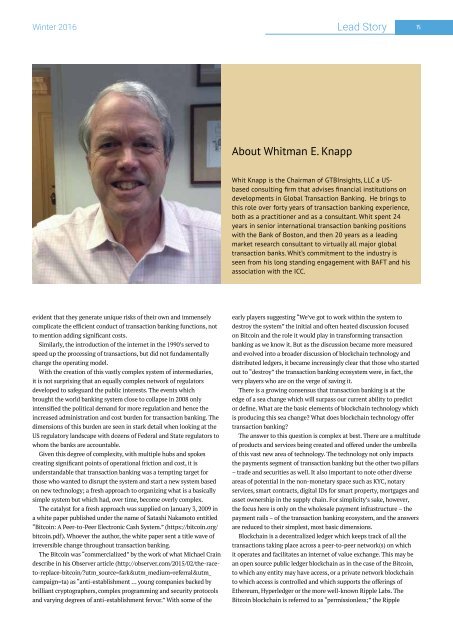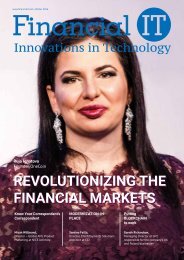Revolutionizing the Financial Markets
You also want an ePaper? Increase the reach of your titles
YUMPU automatically turns print PDFs into web optimized ePapers that Google loves.
Winter 2016 Lead Story 15<br />
About Whitman E. Knapp<br />
Whit Knapp is <strong>the</strong> Chairman of GTBInsights, LLC a USbased<br />
consulting firm that advises financial institutions on<br />
developments in Global Transaction Banking. He brings to<br />
this role over forty years of transaction banking experience,<br />
both as a practitioner and as a consultant. Whit spent 24<br />
years in senior international transaction banking positions<br />
with <strong>the</strong> Bank of Boston, and <strong>the</strong>n 20 years as a leading<br />
market research consultant to virtually all major global<br />
transaction banks. Whit’s commitment to <strong>the</strong> industry is<br />
seen from his long standing engagement with BAFT and his<br />
association with <strong>the</strong> ICC.<br />
evident that <strong>the</strong>y generate unique risks of <strong>the</strong>ir own and immensely<br />
complicate <strong>the</strong> efficient conduct of transaction banking functions, not<br />
to mention adding significant costs.<br />
Similarly, <strong>the</strong> introduction of <strong>the</strong> internet in <strong>the</strong> 1990’s served to<br />
speed up <strong>the</strong> processing of transactions, but did not fundamentally<br />
change <strong>the</strong> operating model.<br />
With <strong>the</strong> creation of this vastly complex system of intermediaries,<br />
it is not surprising that an equally complex network of regulators<br />
developed to safeguard <strong>the</strong> public interests. The events which<br />
brought <strong>the</strong> world banking system close to collapse in 2008 only<br />
intensified <strong>the</strong> political demand for more regulation and hence <strong>the</strong><br />
increased administration and cost burden for transaction banking. The<br />
dimensions of this burden are seen in stark detail when looking at <strong>the</strong><br />
US regulatory landscape with dozens of Federal and State regulators to<br />
whom <strong>the</strong> banks are accountable.<br />
Given this degree of complexity, with multiple hubs and spokes<br />
creating significant points of operational friction and cost, it is<br />
understandable that transaction banking was a tempting target for<br />
those who wanted to disrupt <strong>the</strong> system and start a new system based<br />
on new technology; a fresh approach to organizing what is a basically<br />
simple system but which had, over time, become overly complex.<br />
The catalyst for a fresh approach was supplied on January 3, 2009 in<br />
a white paper published under <strong>the</strong> name of Satashi Nakamoto entitled<br />
“Bitcoin: A Peer-to-Peer Electronic Cash System.” (https://bitcoin.org/<br />
bitcoin.pdf). Whoever <strong>the</strong> author, <strong>the</strong> white paper sent a title wave of<br />
irreversible change throughout transaction banking.<br />
The Bitcoin was “commercialized” by <strong>the</strong> work of what Michael Crain<br />
describe in his Observer article (http://observer.com/2015/02/<strong>the</strong>-raceto-replace-bitcoin/?utm_source=fark&utm_medium=referral&utm_<br />
campaign=ta) as “anti-establishment … young companies backed by<br />
brilliant cryptographers, complex programming and security protocols<br />
and varying degrees of anti-establishment fervor.” With some of <strong>the</strong><br />
early players suggesting “We’ve got to work within <strong>the</strong> system to<br />
destroy <strong>the</strong> system” <strong>the</strong> initial and often heated discussion focused<br />
on Bitcoin and <strong>the</strong> role it would play in transforming transaction<br />
banking as we know it. But as <strong>the</strong> discussion became more measured<br />
and evolved into a broader discussion of blockchain technology and<br />
distributed ledgers, it became increasingly clear that those who started<br />
out to “destroy” <strong>the</strong> transaction banking ecosystem were, in fact, <strong>the</strong><br />
very players who are on <strong>the</strong> verge of saving it.<br />
There is a growing consensus that transaction banking is at <strong>the</strong><br />
edge of a sea change which will surpass our current ability to predict<br />
or define. What are <strong>the</strong> basic elements of blockchain technology which<br />
is producing this sea change? What does blockchain technology offer<br />
transaction banking?<br />
The answer to this question is complex at best. There are a multitude<br />
of products and services being created and offered under <strong>the</strong> umbrella<br />
of this vast new area of technology. The technology not only impacts<br />
<strong>the</strong> payments segment of transaction banking but <strong>the</strong> o<strong>the</strong>r two pillars<br />
– trade and securities as well. It also important to note o<strong>the</strong>r diverse<br />
areas of potential in <strong>the</strong> non-monetary space such as KYC, notary<br />
services, smart contracts, digital IDs for smart property, mortgages and<br />
asset ownership in <strong>the</strong> supply chain. For simplicity’s sake, however,<br />
<strong>the</strong> focus here is only on <strong>the</strong> wholesale payment infrastructure – <strong>the</strong><br />
payment rails – of <strong>the</strong> transaction banking ecosystem, and <strong>the</strong> answers<br />
are reduced to <strong>the</strong>ir simplest, most basic dimensions.<br />
Blockchain is a decentralized ledger which keeps track of all <strong>the</strong><br />
transactions taking place across a peer-to-peer network(s) on which<br />
it operates and facilitates an internet of value exchange. This may be<br />
an open source public ledger blockchain as in <strong>the</strong> case of <strong>the</strong> Bitcoin,<br />
to which any entity may have access, or a private network blockchain<br />
to which access is controlled and which supports <strong>the</strong> offerings of<br />
E<strong>the</strong>reum, Hyperledger or <strong>the</strong> more well-known Ripple Labs. The<br />
Bitcoin blockchain is referred to as “permissionless;” <strong>the</strong> Ripple







